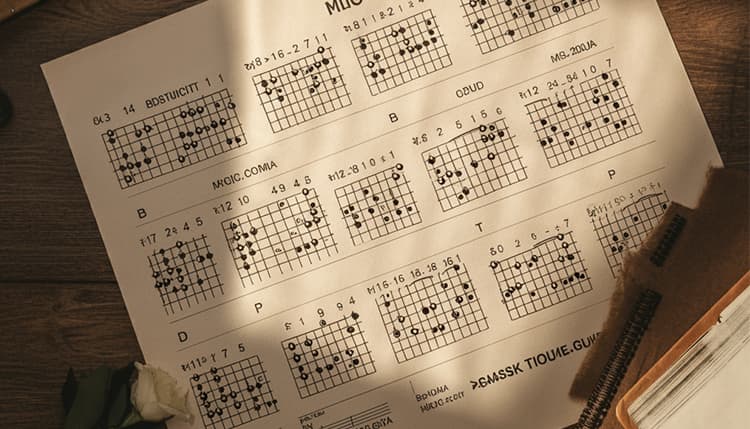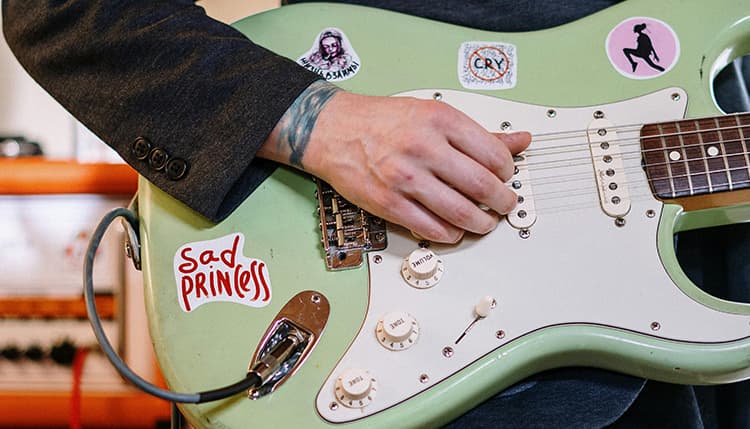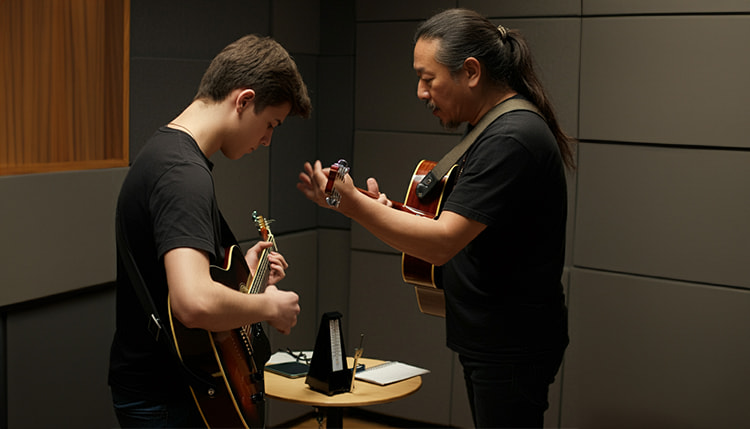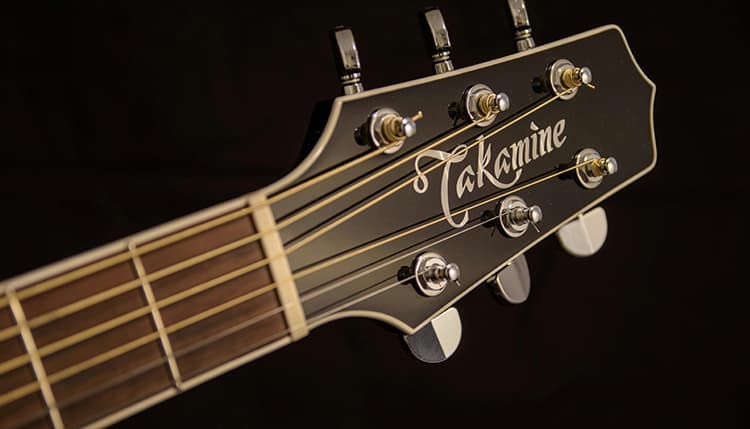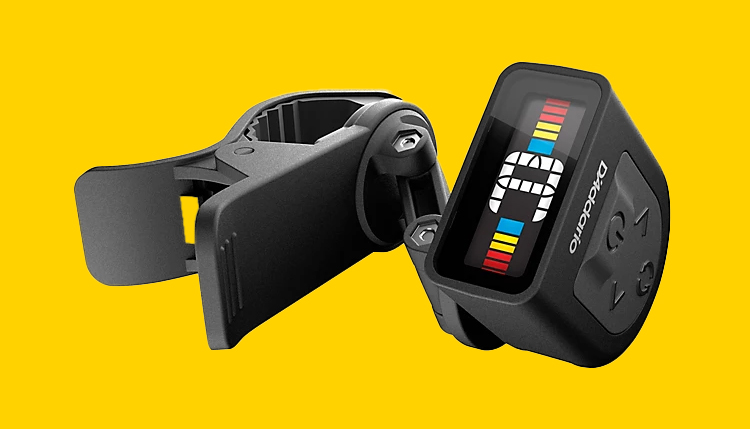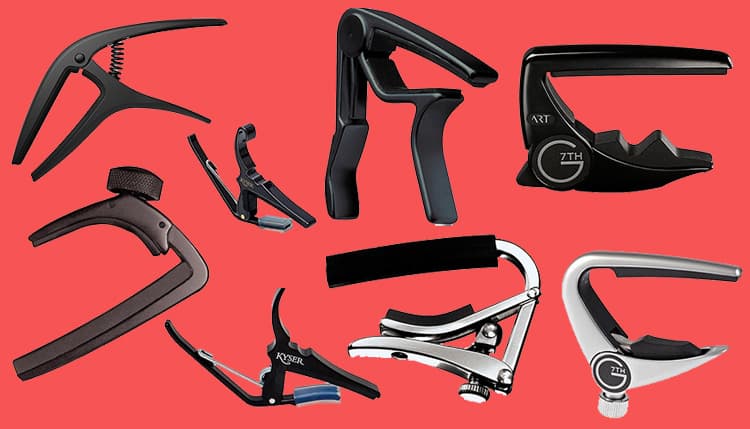Basics of How to Play Guitar
Alright, let’s kick off with the nitty-gritty and learn how to play guitar. First things first is to get to know the different parts and the different guitars out there all waiting for you to strum to your heart’s delight!
Understanding Guitar Components
Okay folks, you’ll need to get a grip on your guitar parts to sound awesome. Here’s how they go:
- Body: The big ol’ bit that hugs your tummy.
- Neck: The runway your fingers strut across.
- Fretboard: Right on the neck where all the finger magic—or chaos—happens.
- Frets: Those shiny metal dividers guiding your fingers to different notes. They’re like musical rulers.
- Headstock: The neck’s final frontier, home to the all-important tuning pegs.
- Tuning Pegs: Turn these bad boys to adjust the string tension and nail the pitch.
- Bridge: This keeps the strings put on the body—without it, they’d be flapping in the breeze.
- Pickups (for electrics): They swap string vibes for electric signals, turning your riffs up to 11.
- Strings: Most of the time, you get six of ’em: E, A, D, G, B, E..
Types of Guitars
Guitars come in flavors for every tune. Let’s sample the spread:
| Guitar Type | Strings | Usage |
|---|---|---|
| Acoustic | 6 | Does it all: folk, rock, you name it! |
| Electric | 6 | Rock, jazz, pop—plug it in, crank it up! |
| Classical | 6 (nylon) | Perfect for that classical, flamenco vibe—think Spanish sunsets. |
| 12-String | 12 (paired) | More strings, more zing—lush sound for folk and rock. |
| Harp Guitar | Varies | A quirky mashup of guitar and harp for those feeling adventurous |
| 7-String | 7 | Metalheads and jazz buffs, this one’s got your lower tones. |
| 8-String | 8 | Stretching the note range for progressive jams. |
| Baritone | 6 | Lower-tuned for those rich, deep sounds in all sorts of genres. |
Most guitars—be they acoustic guitars, electric, or classical—come with six strings, all tuned to E, A, D, G, B, and E. That gives you a great mix to explore a world of sounds.
Once you get comfy with these pieces and styles, you’ll find that guitars are as versatile as they come. We’ll be rocking along with you as you dive deeper into learning how to play guitar like a pro.
How to Play Guitar Chords
So you’re ready to learn how to play guitar, huh? Let’s cut to the chase and get strummin’ by learning those basic chords.
We’re chatting about power chords, open chords, and bar chords. Let’s get our fingers dancing on those strings and make some noise.
And if you need to learn how to read guitar tabs so you can play all these chords it’s not has hard as you might think.
Power Chords vs. Open Chords
Power Chords
Okay, first up, we got power chords. If rock and roll had its own food group, power chords would be it.
Seriously, these bad boys are the bread and butter of rock music. They keep it simple with just two ingredients: the root note and the fifth.
Since you only press down on two or three strings, they’re super easy on the fingers. Perfect for beginner guitar players who don’t want to feel like they’re doing finger yoga just yet.
| Power Chord | Root Note | Fifth Interval |
|---|---|---|
| A5 | A | E |
| B5 | B | F# |
| C5 | C | G |
| D5 | D | A |
| E5 | E | B |
| F5 | F | C |
| G5 | G | D |
Open Chords
Next, we’re diving into open chords. These are your bread and butter chords—great for acoustic jams or just when you want that fuller sound.
They use open strings, meaning some strings ring out without pressing down on them, creating a rich sound that’s like a nice musical hug.
You’ll get the hang of the classics like A, C, D, E, and G. Master these and you’re halfway to being a campfire hero.
| Open Chord | Fingering | Sound Quality |
|---|---|---|
| A Major | 0-2-2-2-0 | Bright |
| C Major | 0-3-2-0-1-0 | Warm |
| D Major | 0-0-0-2-3-2 | Bright |
| E Major | 0-2-2-1-0-0 | Full |
| G Major | 3-2-0-0-0-3 | Rich |
Bar Chords and Their Function
Now, let’s talk about bar chords—or barre chords if you’re feeling fancy. Get ready to level up your playing.
They need a bit more finesse because you’re using one finger like a capo to hold down multiple strings.
But here’s the magic part: once you nail these, you can shift your hand up and down the neck playing the same shape to get different chords. Think of it as unlocking infinite chords with one key. Who said magic isn’t real?
Major Bar Chords
| Bar Chord | Chord Shape | Root Note |
|---|---|---|
| F Major | E shape | F |
| G Major | E shape | G |
| A Major | E shape | A |
| B Major | E shape | B |
| C Major | E shape | C |
Minor Bar Chords
| Bar Chord | Chord Shape | Root Note |
|---|---|---|
| F Minor | E minor shape | F |
| G Minor | E minor shape | G |
| A Minor | E minor shape | A |
| B Minor | E minor shape | B |
| C Minor | E minor shape | C |
Bar chords fit right in with genres like rock and jazz, perfect for playing with a fuller sound that gets toes tapping. They’re a powerhouse for changing keys on the fly too.
Fun fact: next time you crank out a sick tune, you can thank bar chords for that full-bodied awesomeness.
You need to learn how to read guitar chords but by getting these foundational chords in your toolbox, you’re setting yourself up to explore all sorts of musical flavors.
Before long, you’ll be blasting through progressions like a pro. Now, go on and rock those strings! 🎸
Techniques for Learning How to Play Guitar
Grabbing that guitar pick like a pro and nailing hand positions are where the magic starts. We’re talking skills that’ll make your jam sessions not just sound better but feel easier on your hands.
Holding the Pick Correctly
Getting the hang of holding the pick changes the game:
- Curl the Index Finger: Bend that index and snugly tuck the pick beneath your thumb parallel-style, instead of the usual criss-cross. This grip packs some serious oomph, giving your music a beefier and louder sound.
- Control Depth: Now, a heads-up – while your strings might sing louder, this technique may make it trickier to glide through the strings smoothly. If you’re aiming for silky rhythms, you might need to practice not going too deep.
Check out this little comparison of pick grips:
| Pick Holding Technique | Pros | Cons |
|---|---|---|
| Parallel under thumb | Stronger, bolder sound | Trickier depth control |
| Perpendicular under thumb | Easy-peasy control | Milder tone |
Check out our full articles on how to hold a guitar pick and how to hold a guitar.
Importance of Hand Position
Getting your hands in the right spots on the fret board can make you feel like a guitar hero! It boosts precision and speed while keeping cramps and injuries at bay.
- Use Fingertips: Tap those strings with your fingertips. This brings out crystal-clear notes and makes jumping between chords a breeze.
- Thumb Position: Keep your thumb resting behind the middle finger on the guitar neck. It’s all about that leverage and control, folks.
- Perfect Fretting Position: Press right behind the frets, never directly on them to skip the buzzes and nail those clean sounds.
Here’s your quick guide to snazzy hand positioning:
- Press strings with fingertips.
- Thumb chills behind the middle finger.
- Right behind the frets for no-buzz tones.
Adding these sweet tricks into your routine will level up your guitar game big time. So, keep on tweaking your pick hold and hand stance to make every strum count. Let’s make our songs sound as epic as we imagine them!
Essential Guitar Chords
You really want to learn how to play guitar? Well, you’re gonna need these chords in your toolbox. Think of them as the ABCs of music. Let’s jump in and get you rocking with seven must-know beginner chords.
A Major Chord
The A major chord is like that old buddy who’s always around—reliable and sounds good. You’ll see it pop up in tons of songs.
Chord Diagram:
E|---|---|---|---|
B|---|-O-|---|---|
G|---|-O-|---|---|
D|---|-O-|---|---|
A|---|---|---|---|
E|---|---|---|---|
Fingering:
- Index finger on the 2nd fret of the D string
- Middle finger on the 2nd fret of the G string
- Ring finger on the 2nd fret of the B string
- Strum from the A string down
C Major Chord
Ah, the C major chord—it’s got this great, full sound that’s like a warm hug in musical form. Essential in countless hits.
Chord Diagram:
E|---|---|---|---|
B|---|---|---|---|
G|---|---|---|---|
D|---|-O-|---|---|
A|---|---|-O-|---|
E|---|---|---|---|
Fingering:
- Ring finger on the 3rd fret of the A string
- Middle finger on the 2nd fret of the D string
- Index finger on the 1st fret of the B string
- Strum from the A string down
G Major Chord
The G major chord is like the Swiss Army knife of chords—versatile and handy in all sorts of tunes.
Chord Diagram:
E|---|---|---|-O-|
B|---|---|-O-|---|
G|---|---|---|---|
D|---|---|---|---|
A|---|---|-O-|---|
E|---|---|---|-O-|
Fingering:
- Middle finger on the 3rd fret of the E string
- Index finger on the 2nd fret of the A string
- Ring finger on the 3rd fret of the B string
- Strum from the E string down
D Major Chord
Craving a bright sound? The D major chord shines like the sun; it’s perfect for transitions in your play.
Chord Diagram:
E|---|---|---|-O-|
B|---|---|-O-|---|
G|---|---|-O-|---|
D|---|---|---|---|
A|---|---|---|---|
E|---|---|---|---|
Fingering:
- Index finger on the 2nd fret of the G string
- Ring finger on the 3rd fret of the B string
- Middle finger on the 2nd fret of the e string
- Strum from the D string down
E Major Chord
E major has got to be your pal if you’re into blues or rock. It’s a staple chord for those genres.
Chord Diagram:
E|---|---|---|---|
B|---|---|---|---|
G|---|---|---|---|
D|---|---|---|---|
A|---|---|---|-O-|
E|---|---|---|-O-|
Fingering:
- Middle finger on the 2nd fret of the A string
- Ring finger on the 2nd fret of the D string
- Index finger on the 1st fret of the G string
- Strum all the strings
A Minor Chord
Add a splash of drama with the A minor chord. It’s got a moody vibe that’s just right for adding depth to your tracks.
Chord Diagram:
E|---|---|---|---|
B|---|---|---|---|
G|---|---|---|-O-|
D|---|---|---|-O-|
A|---|---|---|-O-|
E|---|---|---|---|
Fingering:
- Index finger on the 1st fret of the B string
- Middle finger on the 2nd fret of the D string
- Ring finger on the 2nd fret of the G string
- Strum from the A string down
B Minor Chord
This one, folks, is the mountain you gotta climb—tricky but well worth the effort. The B minor chord opens up all sorts of musical doors.
Chord Diagram:
E|---|---|---|---|
B|---|---|-O-|---|
G|---|---|-O-|---|
D|---|---|-O-|---|
A|---|-O-|-O-|---|
E|---|---|---|---|
Fingering:
- Index finger on the 2nd fret of the A string
- Middle finger on the 2nd fret of the D string
- Ring finger on the 3rd fret of the B string
- Pinky finger on the 4th fret of the e string
- Strum from the A string down
Nailing these chords is like getting a golden ticket to guitar wonderland. With practice, you’ll have these down pat and be jamming out your favorite songs before you know it!
Need more? Scoot on over to Be Natural Music for extras and iMusic School for some take-home goodies!
Improving Guitar Skills
Wanna learn how to play guitar like a rockstar? Let’s chat about how sticking with practice and maybe snagging some expert advice could be a game-changer.
Here, we’re gonna talk about jamming with a metronome and why some professional lessons might just be your best bet.
Practice with Metronome
Ever tried tapping your foot to a song and struggled to keep up? Practicing with a metronome can turn that struggle into a solid groove.
A metronome is your secret weapon for nailing that timing, which is a big win when you’re jamming with a band or just shredding solo. Start slow—like, snail-paced slow—then crank it up as you get better.
Here’s a cool exercise: the Caterpillar Exercise.
You kick it off at 70 beats per minute (bpm) and work up to 120 bpm. Start with one note per beat and then ramp up the number.
Boom, you’re building finger agility and upping your guitar game.
Just remember to keep your brain in the game and dodge distractions like Netflix (we see you, binge-watchers) while practicing.
Metronome Practice Table:
| Exercise | Starting Tempo (bpm) | Intermediate Tempo (bpm) | Advanced Tempo (bpm) |
|---|---|---|---|
| Chord Switching | 60 | 80 | 100 |
| Scales | 70 | 100 | 120 |
| Caterpillar Exercise | 70 | 90 | 120 |
Benefits of Professional Lessons
Sure, you can teach yourself, but having a pro by your side is like having a GPS for your guitar journey. With personalized advice, they’ll make sure you’re not just playing chords but actually rocking them.
These lessons offer a bit of structure—no more floundering around wondering what to practice next. Teachers help you tackle tough spots and get you into cool new techniques, making your guitar vibes grow fast and your self-esteem soar.
Check out these perks of having a guitar guru:
- Personalized Instruction: Get feedback that’s tailored to what you need most.
- Structured Learning: Follow a roadmap to success—no guessing games.
- Technique Improvement: Fix up your hand positions and get that thumb right where it belongs.
- Motivation and Accountability: Regular lessons keep you pumped and on track with practice.
Whether you’re vibing with a metronome or hanging with an instructor, the core of becoming a guitar legend is all about sticking with it, keeping your ears and mind open, and always looking to learn and get better.
Exploring Guitar Parts
If we’re aiming to lear how to play guitar like a pro, knowing its bits and pieces is the first step. Every part has a job, making sure we strum out some heavenly tunes. So, let’s break down the parts of all the best guitar brands: headstock, neck, tuning pegs, and fretboard.
The Headstock and Its Role
Picture the headstock as the boss of string vibes, found at the neck’s end. It’s the thing keeping your guitar’s strings tight and pitch-perfect.
The headstock does this by holding the tuning pegs, letting us tweak the strings until they sound just right. Without it, our tunes would be far from smooth sailing.
| Headstock Jobs |
|---|
| Keeps strings tight |
| Holds those pegs |
| Tunes the tune |
Understanding the Guitar Neck
The neck is that long, skinny part linking headstock to the body. This part’s where the magic happens—the fretboard. That’s the spot we use to change up the notes and churn out funky rhythms. Getting to grips with how the neck’s put together makes sure we’re comfy while jamming.
| Neck Highlights |
|---|
| Bridges headstock to body |
| Holds the fretboard |
| Makes playing fun |
Tuning Pegs and Their Function
Tuning pegs are like the dial on your radio, only they live on the headstock and make your strings sing. Twist these bad boys, and you control the string tension, upping or lowering the pitch until it’s just right. Without them, our guitar would be singing in its worst voice impossible.
| Tuning Peg Duties |
|---|
| Adjust string tightness |
| Fine-tune string pitch |
| Keeps the guitar in tune |
Fretboard Essentials
The fretboard, or sometimes called the fingerboard, is your musical playground on the neck, usually crafted from wood. It’s lined with frets, which guide you in belting out the right pitches as you press strings against them. Slide your fingers around, and you’ve got endless chords and melodies at your fingertips.
| Fretboard Highlights |
|---|
| Attaches to neck |
| Separated by frets |
| Sets note pitches |
Knowing these vital guitar parts puts us a step ahead, letting us rock with style and self-assurance.
Advanced Guitar Configurations
Calling all guitar enthusiasts! If you love strumming away, diving into different setups can really spice up your musical adventure.
Let’s check out some cool guitars that might just add a little magic to your playing.
12-String Guitars
Ever dreamt of a sound as lush as a forest? That’s where the 12-string guitar steps in, with its string pairs doing a kind of two-step: one string tuned higher than its buddy. The result? A delightful symphony perfect for jams in folk, rock, and pop arenas.
| String Setup | Number of Strings |
|---|---|
| Classic 6-String | 6 |
| Dazzling 12-String | 12 (6 sassy pairs) |
Harp Guitars
Imagine mashing a guitar and harp together. That’s sorta what harp guitars are about, blending guitar swagger with harp mystery. They’ve got your regular 6-string neck, plus some extra lower strings that make for a grander, echo-y mix—great for weaving rich musical tapestries.
| Guitar Style | Extra Strings |
|---|---|
| Basic Guitar | 0 |
| Harp Guitar | 1 or more deep notes |
7-String Guitars
Want to rock some jazz fusion or metal grooves? Cue the 7-string guitar, featuring an extra low B string that lets you dig down into deeper notes and juicy chord arrangements. It’s like giving your music a bulkier, bolder voice.
| String Setup | Number of Strings |
|---|---|
| Regular Guitar | 6 |
| 7-String Wonder | 7 (with that cool extra B) |
Baritone Guitars
For those who lean into those deep, growling tones—baritone guitars got your back. With longer necks and lower tunings, they produce sounds that rattle the walls in rock and metal tunes. Forget about your standard guitar in this league; baritones bring that heavy stomp.
| Guitar Type | Tune It Up |
|---|---|
| Regular | E-A-D-G-B-E |
| Baritone | B-E-A-D-F#-B (or drop it even more) |
Digging into these guitar setups can really rev up our playing. Each variety has its own musical secrets, letting us broaden our song selection and step up our guitar game. Grab your pick—it’s playtime!
Alternate Tunings and Their Impact
To truly embrace the spirit of musical adventure you need to know how to string a guitar and we gotta dive headfirst into the exciting universe of alternate tunings. These can seriously shake up the sound and vibes of our guitars, opening up a funhouse of tonal possibilities and sparking heaps of creativity.
Tonal Variations
Alternate tunings let us jazz up the soundscape of our guitars. Playing puppet master with string pitches can unveil unique harmonics and vibes that stay hidden in standard tuning. We step into an undiscovered world of sound, letting us play around with chord voicings, stretch out on the harmonic range, and even up our stylistic game.
| Tuning | Setup | What’s It Good For? |
|---|---|---|
| Standard | E A D G B E | The go-to setup in almost every genre. |
| Drop D | D A D G B E | Rocks out with deeper, heftier vibes in rock and metal. |
| DADGAD | D A D G A D | Known for its breezy, open sound. |
| Open G | D G D G B D | Rings out a major chord, perfect for some slide action in blues. |
When we mess around with these tunings, we start to see how each one tweaks chord structures and the overall vibe of our sound. It’s like a treasure hunt for that one-of-a-kind tone that only we can call our own, letting us stretch and bend the rules of regular guitar music like a crafty musical contortionist.
Creative Possibilities
What makes alternate tunings a thrill ride isn’t just how they sound—it’s the creative doors they fling wide open. They can give our songwriting a fresh twist, spark wild improvisational ideas, and push us into uncharted territory with new playing styles.
- Jazzed-Up Chord Shapes: Alternate tunings make those tough chord shapes friendlier on our fingers. We can throw richer harmonies and extended chords into our mix like we’re seasoned pros.
- Melody Magic: Tunings like DADGAD or Open G let us play around with tunes that dance around drone notes or open strings. It’s like we’re painting melodies with richer hues and textures.
- Genre Hopping: Certain tunings vibe best with specific genres. Drop D digs the heavy life in rock and metal, while Open G loves to groove in the world of blues and slide guitar.
By giving alternate tunings a whirl, we kick stale routines to the curb and flip the script on ordinary playing habits. We find fresh paths to channel our musical personality.
Whether we’re crafting new tunes or adding a kick to our sets, trying out alternate tunings is a playground packed with fun for every guitarist itching for something more.
Still Wanna Learn How to Play Guitar?
We’ve strummed our way through the guitar galaxy, from getting to know your six-string sidekick to diving into the deep end with alternate tunings.
Learning how to play guitar isn’t about overnight success—it’s about enjoying the journey, one chord at a time.
Whether you’re rocking out with power chords, serenading with open chords, or flexing your fingers with bar chords, keep at it!
Don’t forget to practice with a metronome to keep your timing tight, and maybe even consider some pro lessons to level up your skills.
As you explore different guitar types and tunings, you’ll discover your own unique voice. Maybe you’ll find yourself vibing with a 12-string’s lush tones or getting down and dirty with some guitar pedals. The guitar world is your oyster, so don’t be afraid to experiment!
Remember, every guitar legend started right where you are now. So keep those calluses growing, your pick hand moving, and your passion burning. Whether you’re dreaming of rocking stadiums or just jamming in your bedroom, you’ve got this!
Bass player? Check out how to play bass guitar.
Now, go make some noise! Your musical adventure is just beginning, and trust us—it’s going to be one heck of a ride.
Rock on, guitar heroes in the making!
References
- https://danvillemusic.com/blogs/showcase/how-many-strings-does-a-guitar-have
- https://www.benaturalmusic.live/guitar-chords-for-beginners
- https://guitarnutrition.com/blog/the-most-important-exercise-to-get-good-at-the-guitar
- https://nashville.mi.edu/parts-of-the-guitar
- https://www.sagemusic.co/blog/how-many-strings-on-a-guitar


